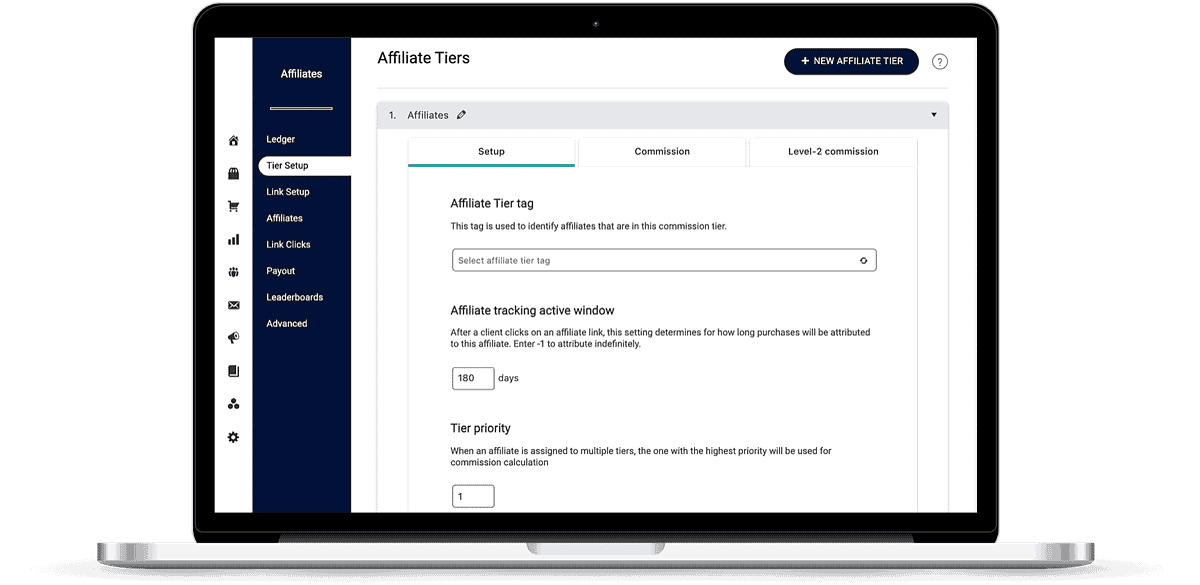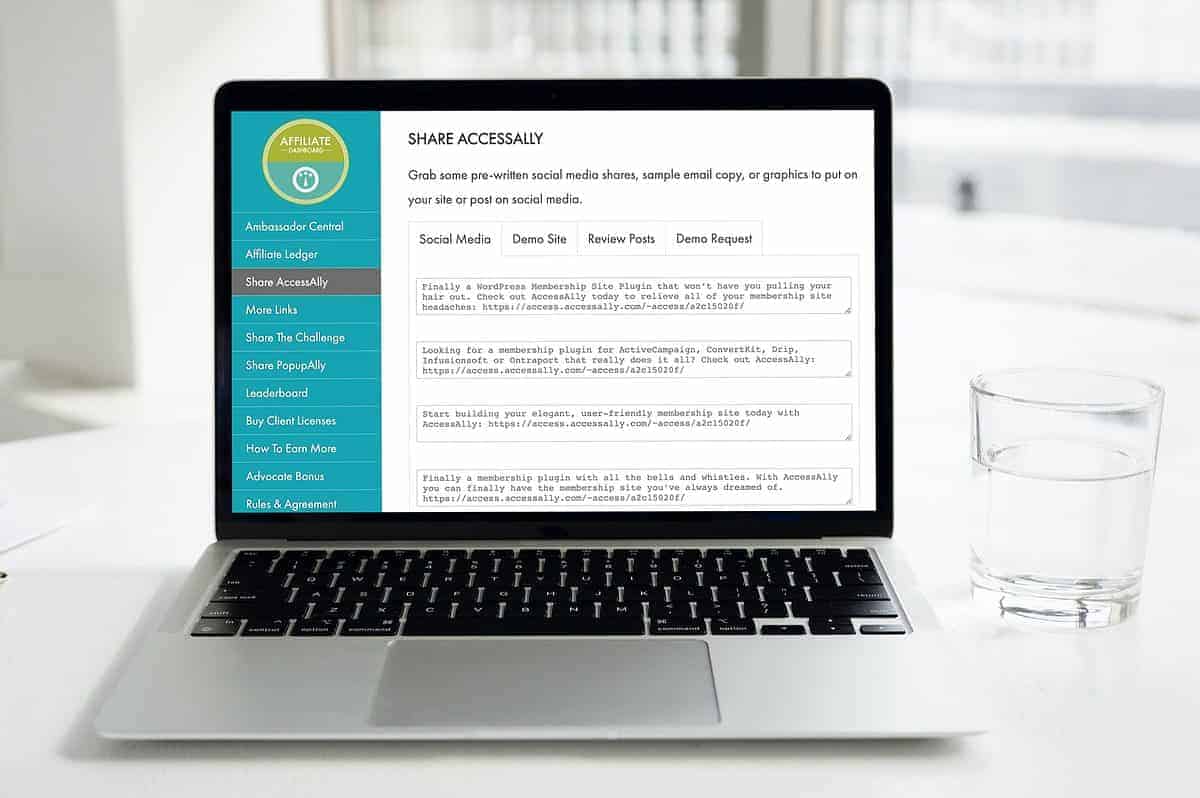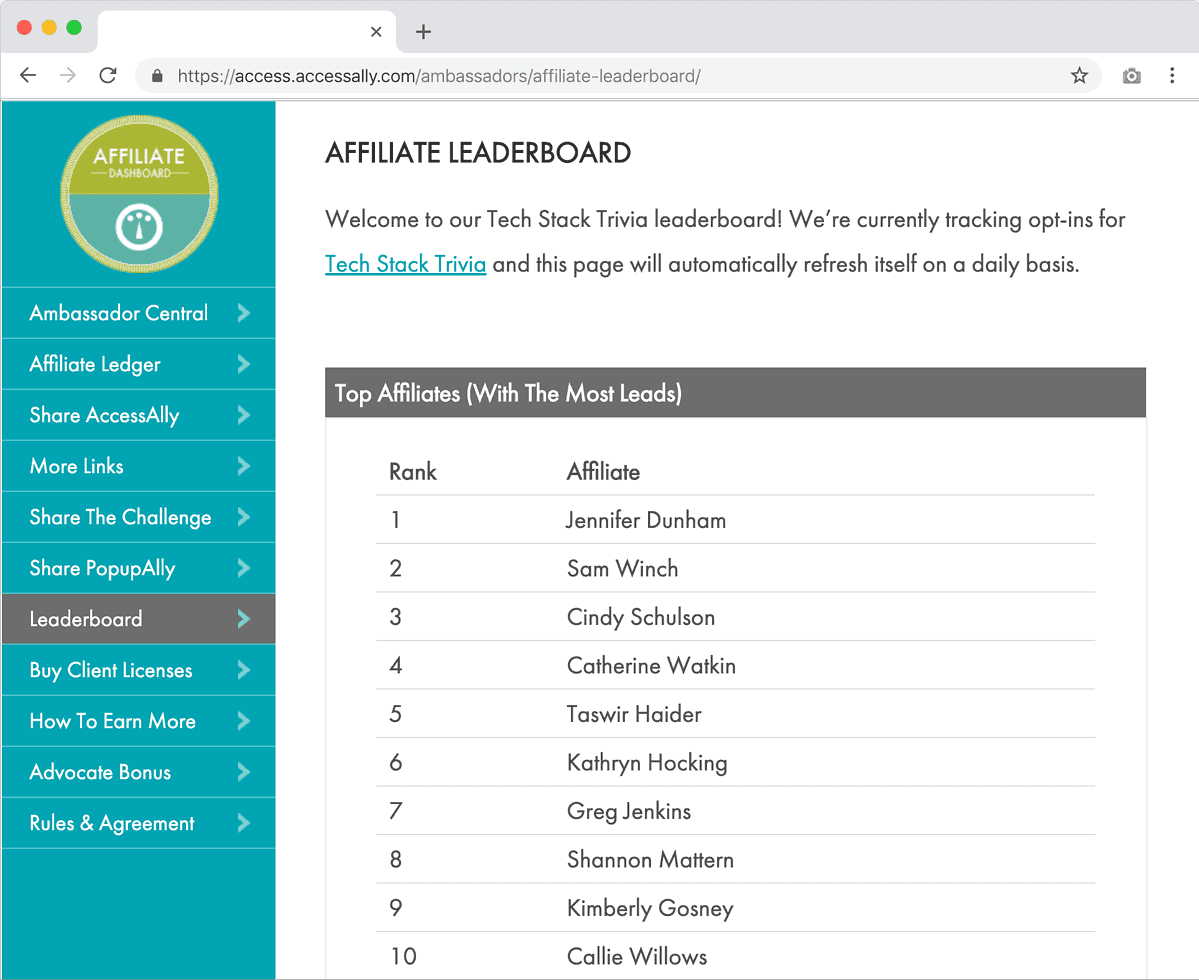Timing is everything, especially when it comes to determining how to start an affiliate program for your business.
If you start too early you might end up losing credibility with your affiliates if your affiliate setup is disorganized. But if you wait too long, you might miss out on valuable revenue and reach for your business, including potential affiliate income.
Now, let me be clear: creating a makeshift affiliate marketing strategy isn’t a magical growth accelerator for a struggling business.
However, if you’re successfully selling your online courses, but notice as soon as you take a break and stop marketing and selling the sales stop coming in – it might be time to create your own affiliate pro
However, if you’re successfully selling your online courses, but notice as soon as you take a break and stop marketing and selling, the sales from actual customers stop coming in – it might be time to create your own affiliate program.
Keep in mind that a successful affiliate or referral program requires structure and nurturing key affiliate relationships.
In this post, we’ll dive into how to create and run an affiliate program for a successful business.
Keep in mind that a successful affiliate or referral program requires structure and a nurturing environment to bring in those extra sales.
Here’s how you can ensure the success of your affiliate program.
Affiliates Refer Some of Your Best Customers
When you set up an affiliate marketing program, and start getting new customers on a regular basis without doing all of the work yourself, it’s like a breath of fresh air. Your affiliate team can help amplify your reach and drive new affiliate revenue for your digital or physical products while earning a commission for their efforts.
Instead of having to launch all the time, you’ll start waking up to new sales in your inbox.
And the best part is that these new customers oftentimes turn out to be your best customers because they already trust you and are excited to dive into your program.
Here at AccessAlly, we’ve learned so much throughout the years about what makes an affiliate program successful. We have years of experience running affiliate programs for online courses, membership sites, and now software. Watch this video for some of our top affiliate marketing tips and how you can use our plugins to make this easier.
We’ve even developed a robust affiliate software in AccessAlly so you can easily set up your affiliate program along with your online course or membership site. Being able to manage both in the same location with our affiliate dashboard can save you time and money.
Current customers of AccessAlly have found tremendous success by implementing these strategies and nurturing their relationships with their affiliates. By following these steps, you can build a thriving affiliate program that enhances your business growth and boosts your offers for customers.
How to Create an Affiliate Program
Starting an affiliate program is a huge undertaking, both in the setup and in the management of the program itself.
But the payoff (for the right fit) makes it all worthwhile.
So here are the top 5 “practicals” of building your own affiliate marketing program.
5 Must-Dos When Building an Affiliate Program
1. Determine Your Affiliate Program Commission Structure
You have to design your affiliate program commission structure so that you can have a sustainable and lucrative business model.
This starts by analyzing your current online business model. You’ll want to pay close attention to metrics like average revenue, revenue per customer, profits per customer, customer retention rate and customer lifetime value.
You should also look at your traffic volume and traffic sources as well as how much you’re spending on your advertising efforts.
In addition, know how much it costs to create, deliver, and provide support for your courses and products.
Knowing what your fixed and variable costs will tell you 80% of what you need to know to create a sustainable cash payout structure for your affiliate business.
One of the most important things to remember is that you won’t be paying affiliates unless they sell one of your digital products or courses. So unlike advertising or other things that you’re doing for marketing, you have little to no upfront costs. This makes it a little bit easier to give people a good commission percentage when they’re recommending you.


In fact, we’ve seen the percentage of commissions be from 5, 10, 15, and 30%, all the way up to 50%.
The 50% commission structure tends to be pretty common when it comes to online courses and memberships where there’s not as much involved in the delivery of it because most of the work is already done for it.
I’ve even seen successful affiliate marketers award 100% commission to their network of affiliates on the first sale. This tends to happen when there’s a lower price point offer and the owner is really wanting to reach a wider audience with as many potential customers as possible. This 100% commission incentive is designed to motivate affiliates to promote the program.
With this strategy, you’ll get a lot of people promoting you, because they’re essentially able to make money without having to create their own products and services. So that’s an incredible offer.
If you’re selling thousand-dollar services, you won’t necessarily need to designate as high of a percentage as when you’re only selling $20 products.
But on the other hand, most affiliates will appreciate your generosity if you decide to give out a 20 – 50% cut, no matter how much you’re charging for your products.
The other thing to keep in mind when it comes to commission structures is whether you will be giving a recurring commission if this is a recurring subscription product.
You may want to offer commissions on a recurring basis for a specific amount of time, for the first month only, or for the lifetime of a customer.
It’s totally up to you – just take a look at your numbers to see what you can afford.
But be sure that you’re offering enough to make it be worth their while.
2. Decide What Your Affiliate Tiers Will Look Like


Some affiliate programs operate as a one-tier system. In short, this means all of your affiliates earn the same amount of commission.
However, some affiliate programs are multi-tiered where an affiliate can earn commissions on a referred affiliate’s sales as well.
You may even want to create multiple affiliate programs with different levels based on referred sales volumes. This type of setup allows your top affiliates to earn a little higher percentage while newer affiliates may have to work their way up.
Just keep in mind when you’re creating an affiliate program and determining what tiers you will have and what that structure looks like, 20% of your affiliates will bring in 80% of your sales, one hundred percent of the time.
This is the 80/20 rule, and we’ve seen here at AccessAlly. Our top affiliates are earning thousands of dollars per month. Then we have some who have never made a sale.
It’s inevitable with every business, you will have people who sign up for your affiliate program and they may be excited about sharing your offering, but then they get busy with something else and they just don’t have a chance to promote.
We have some strategies later on in this post to really help you get people to promote your offerings, but a lot of times what it comes down to is having incredible relationships with your affiliates.
The more personal you can be with your affiliates, the more of a true relationship you’ll cultivate. People don’t want to just be another number in your business.
They want to be someone who is part of your business and someone who is also going to be rewarded when they’re sending people your way.
You can also name your tiers creatively, to make it more enticing to promote and move up the affiliate levels.
3. Create Your Affiliate Terms and Conditions
When creating an affiliate program, you will need to create your affiliate disclosure, which is basically like terms and conditions for your affiliates.
You’ll either want to work with a lawyer to draft your affiliate terms and conditions or find a template for affiliate agreements and tweak it for your particular business and your needs.
Your affiliate agreement should clearly state the terms and how your affiliate program will work.
Potential affiliates should accept these terms and conditions by acknowledging they accept your terms and conditions via a checkbox on your sign-up form. This helps set expectations for how affiliate sales will be tracked and clearly explains how your affiliate program will run.


One use case you’ll want to be sure to cover in your terms is whether an affiliate can earn a commission if they purchase your product themselves.
Clearly define what your refund period is in your affiliate agreement terms and conditions and when payouts will be issued as well.
Whether you have a 30-day, 60-day, or 90-day refund policy for your courses and products, be sure to account for that in your payout terms to ensure you’re not issuing commission payments within an active refund period.
You also want to clearly outline what types of promotions are permitted.
One method of promotion you’ll want to give careful consideration to is whether you want to permit affiliates to run paid ads on social media platforms such as Facebook ads or using Google ads.
4. Decide Your Affiliate Marketing Program Features
To start, you will want to create an affiliate signup process for affiliates to join your affiliate program.
This is where people will sign up to become an affiliate and accept your affiliate terms and conditions. This process is one of the first pieces of your technical setup.
Your affiliate application for your affiliate marketing program should gather all the details you need from your affiliate marketers, including but not limited to the following:
- An e-mail address for preferred communication.
- A PayPal email address to issue affiliate commissions if you plan to pay your affiliates via PayPal.
- Tax ID so you can issue a 1099 if the affiliate earns commissions in excess of $600.
- Mailing address
This signup process helps ensure you only have quality affiliates applying for your affiliate programs.
Upon completion of the affiliate signup process, your affiliates will get access to your affiliate center.
Your affiliate center is where each affiliate will log in to retrieve their unique affiliate links, any swipe copy or promotional materials you have for them, and where they can access their stats or view an affiliate leaderboard if you host an affiliate contest.
Having a central, organized location for all affiliate-related materials and content will drastically reduce the number of inquiries that you or your team has to field. This also builds trust between you and your affiliates and makes promoting as easy as possible for them.
Be sure to watch the video above to get an inside look at how AccessAlly allows you to create a top-notch affiliate program and sophisticated affiliate center.
Depending on the affiliate management software that you choose, you could be limited in your setup so be sure to choose a tool that has all of the features you want and need so you can create a great user experience for your affiliates.
5. Choose an Affiliate Plugin or Platform
The software “brain” behind your WordPress affiliate program is really the one that ensures all the features (listed above) are readily available and functioning.
Because of this, it’s definitely recommended to use a robust affiliate marketing software that thoroughly integrates with your CRM, ecommerce software, marketing funnels, and Google Analytics – whether that’s a third-party tool or something that’s already built into your current tech setup.
For example, we used Keap Max Classic’s (formerly known as Infusionsoft) affiliate center for years to host and track our affiliate program and were happy with its performance, but the native affiliate center for Keap Max Classic left a lot to be desired in terms of design and layout.
After we added affiliate management functionality to our AccessAlly plugin, we switched to using that, instead. It gave us more control over the affiliate program setup and user experience.
(So if you’re using any of our integrated CRMs, know that you can use AccessAlly as your WordPress affiliate plugin.)
How to Find the Best Affiliates When Creating Your Affiliate Program
1. The Best Referrals Come From People Who Know Your Program
Sure, anyone can share an affiliate link… but the highest conversion rates come from individuals who have experience with your program (or services and courses) and can give a genuine account of it to their network of trusted relationships.
People see through the get-rich-quick affiliate content scheme, whether it’s coming from your mouth or through user-generated content from your affiliate partners.
So do your due diligence by making sure your program or services are stellar and that you have happy clients who are more than ready to share the news about it all.
2. The Most Valuable Affiliates Have A Following Of Their Own
Want to gather a group of affiliates who are worth their weight in gold? Ally yourself with individuals who have a strong following of their own, which is easier said than done.
To do this, of course, you have to “prove” that your affiliate program is going to be worth their time and attention. You’ll also have to prove that your program offers more potential than the other ones out there.
You’ll also want to make sure that you treat any affiliate’s referral like gold: which is why having a proven product or service makes it easier to onboard affiliates.
No one wants to refer their friends or clients to a bad experience.
If I don’t have a good time at a restaurant, I’m not going to tell my friends to go there because they’ll never trust my recommendations for restaurants! The same is true for anyone who spreads the word as an affiliate.
3. Affiliates Aren’t Going To Put Effort Into A Product That’s Not Selling
Do you know who’s the most loyal affiliate of your program? You.
Your affiliates are in it for the money, otherwise, they would be using affiliate marketing efforts to promote their own products and services.
So if you’re having a tough time making sales on your own, there’s very little reason to believe that your affiliates will do any better.
And, to be totally honest, if the time spent with you isn’t paying off for your affiliates, they’re likely to abandon your program entirely.
Before you invest your time and money into creating an affiliate program, make sure you have your sales process optimized for conversions and have created a great user experience for your offerings.
4. Affiliates Are Looking For An Easy Way To Make Money
And this is 100% ok.
After all, it’s not their course or program to sell, it’s yours.
Your first job is to build something worth promoting.
Your next job is to create the best sharable graphic, social media posts, Instagram stories templates and email swipe file copy that they might possibly need when advertising your program – and make sure it’s all easily accessible. You can create an easy-to-use affiliate center using a WordPress affiliate plugin like AccessAlly.


Many of the strongest affiliates often have full-time gigs of their own and don’t have time to plan an entire marketing strategy around your programs.
Once again, that’s your job. Make it as easy for them as possible!
5. Affiliates Are Also Looking To Build Stronger Relationships
Our AccessAlly Affiliates are some of our all-time favorite business allies. We’ve taken the time to get to know as many of them as possible.
Once an affiliate signs up, that’s just the beginning of your relationship with them. You want to send them emails and reach out to them personally, and really make sure that they are doing their best so that you both win together.
It’s good for all of us when we focus on helping our affiliates succeed: our collective customers benefit and so do we.
Building a strong business means building real relationships. Especially with your affiliates. So be prepared to dedicate quite a bit of time to make sure they have everything they need to be successful including access to technical knowledge and promotional content. (Note: As your affiliate program grows, you may want to invest in hiring and training full-time dedicated affiliate managers to nurture these key business relationships.)
Building a strong business means building real relationships. Especially with your affiliates. So be prepared to dedicate quite a bit of time to make sure they have everything they need to be successful.
If you’ve ever been an affiliate for someone else, you know how much work can go into planning your promotional efforts in support of the program.
If you run multiple launches throughout the year, be sure to share your launch calendar. This gives your affiliates ample time to plan ahead and prepare to promote your offerings.
And remember, make it as easy as possible for them to promote your programs. Provide them with as many materials as you can so they have options.
You also want to make yourself available to your affiliate’s audience as a sales resource for them. Whether that’s to be interviewed on their podcasts or as a guest on one of their webinars, this gives you a chance to connect personally with your affiliate network and their audiences.
You may even be able to showcase your courses and your content yourself, while still leveraging the audience and the business of your affiliates.
Another great way to strengthen the relationship with your affiliates is to host affiliate contests and display leaderboards where your affiliates can compete with each other. Many successful affiliate programs will award additional prizes to their top affiliates based on their efforts.


The Strength Of Your Business Dictates The Success Of Your Affiliates
Jumping the gun and creating an affiliate program “too soon” means that you might not receive the great benefits that you’re craving and hoping to reap from your affiliate program.
Can it still work? Sure.
In the world of online business, anything is technically possible.
But know that your affiliates will quickly see how much or how little dedication you’re putting into it. And the stellar ones aren’t likely to stick around if things aren’t running as smoothly as they could be.
This also means making sure that your affiliate tracking system is fully automated so that there are no awkward mix-ups or payment inconsistencies.
Top Affiliate Programs in 2023
Here are some of the most well-known affiliate programs. It can be helpful to study these programs as you are thinking about your strategy.
1. Amazon Associates
The Amazon Affiliate Program stands as one of the oldest and most expansive affiliate initiatives in existence. It covers the entirety of their online product offerings. So, if you’re able to locate an item on Amazon, you can promote it and receive a slice of the earnings.
Pros
- A platform that is easy to understand and use.
- More than 350+ million products (or options) to promote.
- Amazon is a brand that already has an online presence and recognition around the world.
Cons
- Their commission rates are variable and not standardized.
2.CJ Affiliate
CJ Affiliate also referred to as Commission Junction, stands as a timeless gem in the realm of affiliate marketing.
With a remarkable history spanning over two decades, this affiliate network has blossomed into an expansive marketplace housing a repertoire of over 3,000 products curated from a diverse array of reputable merchants.
Pros
- Marketing tools that can help with campaign optimization
- Free and easy-to-understand onboarding
- A diverse market
Cons
- There is no established timeline for merchants to reply back.
- Seasoned influencers and content creators hold an advantage over the majority of affiliates.
3. ClickBank
ClickBank is another long-runner in the realm of affiliate marketing, and it is quite known as one of the most beginner-friendly affiliate marketing programs.
At its heart lies the Spark educational platform, an invaluable resource crafted to introduce affiliates and merchants to the bedrock skills and essential knowledge important for thriving in the dynamic universe of affiliate marketing.
Pros
- It has high commission rates.
- Exclusive educational content for affiliates and merchants
- An easy-to-use interface
- A very simple sign-up process for both affiliates and merchants
Cons
- There is a lot of competition within affiliate programs
- You need to be patient to generate your first sale
4. ShareASale
ShareASale is an affiliate network of over 25,000 merchants and publishers.
Pros
- It is free to register
- Real-time reporting
- You can create custom affiliate tools
Cons
- The commission depends on the brand you promote, so it varies a lot
- There are limited payout options
5. eBay Partner Network
eBay Partner Network is one of the oldest affiliate marketplace sites, and it has over over 1.4 billion and an audience of 183 million buyers worldwide awaits your overtures.
Pros
- Payouts are available to your bank account or PayPal.
- Low minimum payouts.
- Payouts are sent on the 10th of the following month.
Cons
- Commission structure may be confusing.
6. Rakuten Advertising
Known as the third-largest network in the affiliate realm, Rakuten Advertising commands an impressive 7.15% slice of the affiliate market share. There are over 2,500 captivating affiliate offers on the platform.
Pros
- You have the opportunity to earn different types of commissions.
- A lot of educational materials that can help your career.
Cons
- A smaller number of people looking for affiliates in comparison with other networks
- $50 minimum payout
Some best practices for running an affiliate program
Here are some practical tips to ensure affiliate marketing success.
Define your affiliate marketing KPIs
As a business owner, you need to define your KPIs for affiliate marketing before you create one.
- Are you aiming to expand your customer base and number of customer purchases?
- Is your goal to extend your audience size and increase organic traffic be it from Google and social channels?
- Or perhaps, you are focused on improving customer loyalty?
Asking these questions can help you better understand what a “successful” affiliate program will look like for your business.
Get clear on your ideal customer
Understanding your target audience, as well as the way you will need to market your products and brands is the most important aspect of your affiliate program success.
If you know your audience, you will know what type of marketing channels you can reach them through, what solutions you can provide and your affiliate marketing campaigns can be more effective thanks to it.
Keep it simple
The best thing you can do for any plan you layout is to make it as easy to understand as possible. You don’t want your affiliates to have so many questions that they don’t even know where to start or worse, get overwhelmed by the process.
Imagine your program as a thriving community, where affiliates feel valued and engaged. Regular check-ins, informative updates, and a responsive support system can foster a sense of belonging and motivation among affiliates.
Clear guidelines coupled with a friendly touch ensure that your affiliates are equipped to navigate the landscape with confidence.
Think of your affiliates as valuable members of your business team, because that’s exactly what they are! When you treat them like partners and give them the support they need, they’re more likely to stick around and excel at bringing in that sweet traffic and boosting your sales.
You can help them with different advertising strategies and provide traditional advertising resources to them like banner ad, email copy, and product image templates that could help them post high-quality content within any of their social media channels, boosting your business.
Monitor and optimize everything
You need to keep an eye on things to see if your affiliate strategy is working.
If things aren’t going as smoothly as you hoped, don’t sweat it. It’s like a puzzle, and sometimes a piece or two might need adjusting.
Speaking of Awkward, Expensive Pitfalls…
A lot can go wrong when you’re not totally prepared for (or invested in) an affiliate program. But here are the main 3 pitfalls in affiliate marketing mistakes that we see most often:
Mistake #1: Investing Too Much in A Big System… Without The Payoff
Since affiliate programs tend to be a little more “high-end” on the business investment spectrum, WordPress affiliate plugins typically come with a price tag attached. Yes, there are some WordPress referral plugin options on the low end but you’ll want to make sure they integrate with your existing systems.
Affiliate systems also require a ton of time to manage properly, which means that you might either burn out (if you’re trying to do it all yourself) or have to hire a new tech-savvy team member (which can be quite expensive).
If your affiliates aren’t bringing in enough extra revenue to cover this investment, you can end up in the red.
Mistake #2: Recruiting the wrong type of affiliates
Anyone can be an affiliate, right?
Wrong!
Some affiliates are only in it to make a little money and aren’t as discerning about the type of traffic they’re sending to your products.
We’ve seen a huge influx of website traffic and income from affiliate marketing from referrals… only to have it followed by refunds and returns. These were just not our ideal customers, to begin with.
It’s not just a hassle. It’s a total waste of money and resources to try to get everything straightened out.
Mistake #3: Losing your best affiliates because of poor leadership
Say you’ve successfully avoided mistakes 1 and 2, but then find yourself pulled in many different directions. Yeah, you promised new graphics, more promotions, and an affiliate contest (complete with prizes)… but when it comes right down to it, you don’t have the time.
Unfortunately, neglecting your affiliates can completely annihilate their interest in you and what you have to offer. Because while you were trying to refocus, another company may have stepped in with a better program.
Your affiliates might decide to skip your next promotion or disengage entirely.
Always remember that your affiliates are humans with their own lives! They need inspiration and leadership from you if you’re going to expect any bit of effort from them!
What’s the Next Step In Creating an Affiliate Program?
First, be 100% certain that now is the right time to begin your program.
Then, find the affiliate platform/plugin that will work best for your needs.
Next, spend ample time planning out your promotions and preparing a ton of copy and materials for your affiliates.
How Much “Swipe Copy” Do I Need To Prepare For My Affiliates?
Generally, there are two types of affiliate promotions:
- Evergreen promotions – when your products are always available to purchase.
- Launch promotions – when you’re opening up enrollment or sales for a limited time.
Each type of promotion should include its own set of swipe copy… try to provide a mixture of e-mail and social media swipe copy
- 1-3 pre-written emails (more, if you want them to do a sales sequence with their email lists)
- 3-5 Facebook/LinkedIn/Instagram posts
- 3-5 Twitter posts
- 3-10 unique graphics to use as social media posts, website banners, etc.
Lastly, take the time to recruit affiliates who love your business and are ready to make you proud.
How Many Affiliates Should I Recruit?
Once again, this is totally up to you.
“The more the merrier” isn’t always a good motto to have, since you definitely want your affiliates to be invested in your business and mission.
(Think about it: affiliates who send low-quality traffic to your site will also be sending you less-than-ideal clients who might buy a product quickly… but then cancel just as fast. Total customer service headache!)
At the same time, an effective strategy means you recruit enough affiliates so that you can count on some referrals always coming in, even if some of your affiliates are busy with other things during a promotion.
At the same time, you want to recruit enough affiliates so that you can count on some referrals always coming in, even if some of your affiliates are busy with other things during a promotion.
Find a sweet spot that works for you – possibly setting a “good-better-best” goal to reach when recruiting.
The future of your business might even depend on the strength of your program.







